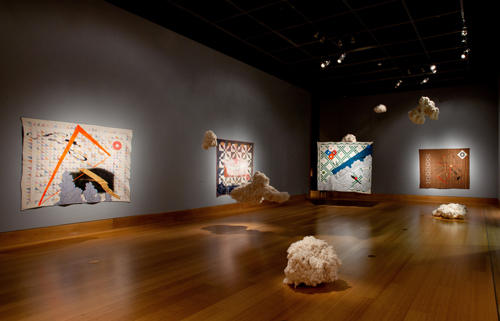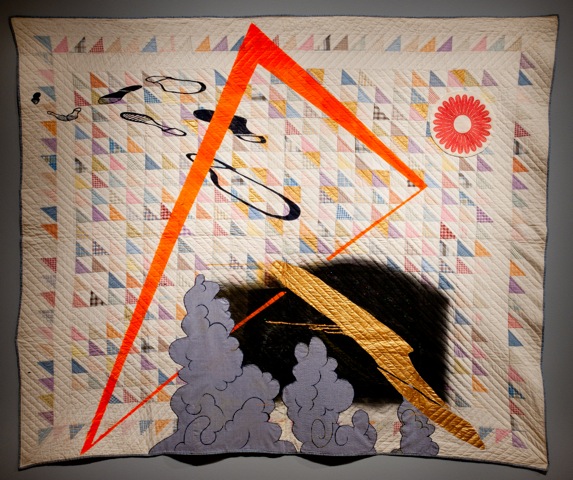
Sanford Biggers. “Codex,” 2012. Courtesy the artist and The John and Mable Ringling Museum of Art. Photography by Giovanni Lunardi.
This week I took a break from my Digital Media doctoral studies at Georgia Tech to see Sanford Biggers’ new work, Codex. Biggers was the first visual art recipient of the Greenfield Prize and his commission was recently installed at the Ringling Museum of Art in Sarasota, FL. I also recently discussed the artist’s Mandala of the B-Bodhisattva II that was on display at Emory University’s Visual Arts Gallery in Atlanta. Biggers merges symbols/codes/objects from the past with contemporary expressions such as hip-hop culture (b-boying). In Codex, he repurposes historical quilts that may have been used on the Underground Railroad as signposts, signaling “stations,” or safe houses. These works re-imagine cultural-historical artifacts of the past using materials of the present to consider possible futures.
“Harriet Tubman was an astronaut, traversing the south to the north by navigating the stars.” – Sanford Biggers
Some scholars argue that African slave artists and craftspeople used quilts much like NASA scientists use star charts. A star chart is a map of the night sky and Underground Railroad Conductor Harriet Tubman may have used one of these charts or quilts to lead dozens of slaves to freedom using the North Star as a guide. Accordingly, Biggers’ use of slave quilts as source material for his art makes reference to Tubman and the secret routes she traveled. One can imagine Tubman creating a model of the sky in her mind or seeking signs along the way, whereas Biggers re-uses quilts – mostly donated by the descendants of slave owners – to connect the past and the present. His quilts provide a base for decorative designs taken from a diverse range of sources. The artist uses spray painted stencils, cloud and wave motifs heavily influenced by the Edo period in Japanese art, sacred geometry (geometric design), and free-floating and floor-level raw cotton “clouds.”

Sanford Biggers. “Codex” (quilt detail). Courtesy the artist and The John and Mable Ringling Museum of Art. Photography by Giovanni Lunardi.
Star charts are visual maps divided by astronomers into grids, then used to identify and locate stars, constellations and galaxies. Astronomical objects are interspersed throughout Biggers’ work, symbolic of the models used by Tubman and others as they found their way to freedom. While I was in the gallery, I made note of a quote by art critic and curator Gregory Volk regarding Sanford Biggers’ reference to maps that,
“[S]ituate the whole work in relation to the cosmos, to immensities, and this is one of the many times in Biggers’ work when fractious and gritty earthly matters are juxtaposed with overwhelming vastness.”
Many quilt designs are based on the Cartesian coordinate system in mathematics – i.e. making half-square (equilateral) triangles. Biggers’ quilts incorporate geometric diagrams and organic shapes in the existing quilts. This process brings to mind the work of Julie Mehretu. The merging of the geometric designs, natural forms, and the grid has an indirect connection to STEAM education, e.g. Science, Technology, Engineering, Art and Mathematics. This intersection of art and STEM is timely, especially as educators worry that the United States is falling further and further behind in STEM fields. During a peer learning session with Sanford (hosted at Emory) I mentioned this as it relates to his work. Making STEAM connections can create new opportunities for creative, collaborative discourse and exchange. I hope to revisit this again as it relates to another exhibition by Biggers, The Cartographer’s Conundrum, now on view at Mass MoCA, as well as my interest in designing art projects that engage learners from ethnic groups who are underrepresented in STEM.
“All my work is created from personal experiences. My hope is always that others will see it as a gateway, develop their own message and feel a part of the art.” – Sanford Biggers
Dr. Matthew McLendon, the Ringling Museum’s associate curator of modern and contemporary art, notes, “Codex plays a significant role in the continued maturation of Sanford Biggers’ work. Here we see the artist reconfiguring symbolism he has used before in three-dimensional forms through the return to his earliest form of expression, painting. As such, the works in Codex offer an unprecedented chance to see Biggers in the process of evolving his artistic practice.” Unlike the traditional definition of a codex –a book bound by joining pages –Biggers has created a series of works that are more randomly presented and, as a whole, constantly reconciling disparate beliefs, systems of thought and forms of expression. This is a contemporary mode of expression that makes use of a disjunctive and open form of artistic and cultural production, as applicable to galleries and museums as it is to classrooms and open source works on the World Wide Web.
Codex is on view at the Ringling Museum of Art through October 14.
The Cartographer’s Conundrum is on view at Mass MoCA through fall 2012.





Pingback: Sanford Biggers’ Conundrum: The Mothership Lands at Mass MoCA | Art21 Blog
Pingback: The My-Stery: Let Me Ride Part 1 « Aker: Futuristically Ancient
Pingback: Sanford Biggers Studio Visit in NYC « SL Art HUD Blog Thingie:
Pingback: Polyculturalist Visions Revisited | Art21 Blog
Pingback: Art21 2009 to the Present « SL Art HUD Blog Thingie:
Pingback: Critical Geography, Spatial Theory & Everyday Life | SL Art HUD Blog Thingie:
Pingback: Shuffle, Shake & Shatter Residency with Sanford Biggers | SL Art HUD Blog Thingie:
Pingback: The My-Stery: Honoring Black Women’s Voices, Bodies and Supernaturalness | Aker: Futuristically Ancient
Pingback: In the Language of Dreams: the African Aesthetic in the Americas | SL Art HUD Blog Thingie:
Pingback: Critical Play: Radical Game Design & STEM | Renegade Futurism
Pingback: 2013: A Year in Review | Renegade Futurism
Pingback: Putting In Work: A Long-Term Dream Is Being Realized | Renegade Futurism